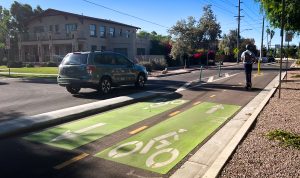In much of the U.S., cold weather means trouble on the highway. The 2017 Infrastructure Report Card issued by the American Society of Civil Engineers (ASCE) gave America’s roads a “D,” saying that “One out of every five miles of highway pavement is in poor condition and our roads have a significant and increasing backlog of rehabilitation needs.” You can pursue a story on the business of your region’s infrastructure by looking at state and local ballot measures, the cost of upkeep, companies engaged in repairs and upkeep, even the science of road construction. Here are nine fun facts about the cost of road infrastructure to pursue.
1. Those ridges have a name
There’s more to building a road than laying concrete. If you’ve ever noticed the grooves in the surface of a road and wondered what they were, the answer is tining. Tining is the act of placing longitudinal lines in concrete before it sets. It’s used to reduce tire-to-pavement noise and can reduce car accidents by adding skid prevention.
2. Rock salt is the never-ending story
During the winter months, states that get snow and ice storms have a large fleet of snow plow trucks with salt spreaders. While there are many kinds of salt, the kind used to melt ice on roads is called rock salt, an underground crystal that requires mining. Detroit discovered its salt reserves in 1895. Salt prices vary depending on your location: Depending on how bad the winter is, a city could spend well over $100,000 on salt in a year. Salt is always a good story because cities sometimes buy too much, or don’t buy enough and have to scramble when they run out. Here are some stats on the prices of different kinds of salt.
3. And then there’s sand
Rock salt is not the only thing that is used on cold wintry roads. Sometimes cities use a mixture of salt and sand. The sand isn’t used to melt the ice, but to prevent ice from forming in the first place. It also provides better traction on slick roads. Cities don’t typically spend nearly as much on sand because it is usually only used when temperatures drop below 12 degrees, when salt is no longer effective. In general sand costs a city much less and there is evidence that shows that it is more better at combating ice.
4. A flash doesn’t mean you’re on camera
Thirteen states in the U.S. have prohibited the use of speed cameras; 12 states, plus the District of Columbia and the U.S. Virgin Islands have operational speed cameras; 28 states don’t have any speed camera laws. If you’re in one of the states that allow them, it pays to know that the light that flashes isn’t the camera itself–it’s a warning to step off the gas. Cars that don’t slow trigger the speed camera. If a speed camera catches you going over the limit in a construction zone, prepare to pay up. Speed camera tickets vary by state, but in Illinois can cost travelers a hefty $375, minimum.
5. New devises lessen impact and costs
A highway attenuation device is a fancy term for those big yellow barrels filled with sand. These barriers are meant to reduce the impact of a collision. Other types of attenuators are built more as a suspension system and can be reset after an impact, protecting the drivers and saving money at the same time.
6. Asphalt roads are usually recycled
RAP, or reclaimed asphalt pavement, refers to the recycling of asphalt pavement for repairing roads and resurfacing. The next time you’re on a road that’s being dug up, look for a loud contraption called a “milling machine.” It digs up the old asphalt and launches the material from a long conveyor and into a dump truck. The asphalt is ground up, processed and re-used. Reclaiming asphalt saves money and is environmentally friendly.
7. Prefab bridges enhance safety and economics
Prefabricated elements are changing how bridges are constructed. Among the large bridges that have prefabricated elements or systems is the world’s tallest bridge, the Millau Viaduct, laregely prefabricated because of its high-altitude design. Prefabricating improves safety for workers and saves money by requiring fewer days of work.
8. Construction zone lane lines can peel right off
Construction zones lines may look painted on, but some of them like Visa-Line are actually thermoplastic tape that comes on rolls. These temporary lines are an economical alternative to painting, durable and easily removed.
9. Road construction stops in winter
If you live in a state where winter is particularly cold, one reason to enjoy the season is that for a few months, road construction ends. When the ground freezes, workers are unable to pave the roads. If a project is almost complete, workers can use heaters to keep paving, but it can be an expensive risk: Paving under 50 degrees often has to be redone.










